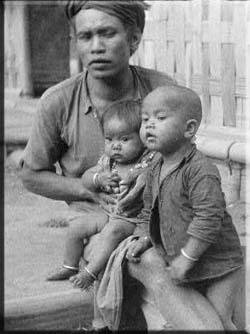
|
|||
A REVOLUTIONARY NEW METHODOLOGY
|
|||
|
|
PART 7:
|
||
 |
Gerald Sullivan is the author of Margaret Mead, Gregory Bateson and Highland Bali: Fieldwork Photographs of Bayung Gedé, 1936-1939 which includes more than 200 photographs from that period.
Margaret Mead and Gregory Bateson arrived in Bali in March 1936. With the assistance of Walter Spies, they began to seek out a preliminary fieldsite. By the end of April, Mead and Bateson had decided to take up residence in Bayung Gedé: "our village, way up in the mountains, a lovely self-contained square village." Mead and Bateson had already attended a variety of ceremonies and dance performances which, as Mead put it, were "high spots [which] together form a sort of pattern of the [psychological] potentialities of Balinese culture." They hoped Bayung Gedé (low and dour by Balinese standards they thought, a dorpsrepubliek or village republic sufficient unto itself according to Mead and Bateson's ex-patriot interlocutors) would provide the keys to the pattern. Once they understood Bayung Gedé, they could move on.
So conceived, the village was an admirable location. It was apparently physically isolated, well up and then off an overly steep back road across the mountains. It was also apparently, at least initially, a socially isolated, largely in-marrying, home to roughly five hundred people, and yet, annoyingly, possessed of its own customs.
Bayung Gedé had been near the epicenter of a large earthquake in 1917. Many of the walls which had previously surrounded individual houseyards and a number of temples had been severely damaged. The temples had been rebuilt; many of the houseyard walls had been replaced with woven fences. These fences gave the village a unique appearance; they also allowed the ethnographers to walk past many houseyards, see what was happening within and proceed on without having to stop and engage in the delicacies of Balinese politesse.
Most important, Mead could easily observe the range of social interactions between persons of all ages and gather, thereby, the "pattern of the potentialities of Balinese culture."
Mead set out to use the methods she had already developed. By late August, Bateson was free to explore the uses of photography and cinematography. They were also increasingly aware of the assistance their aide-de-camp, I Madé Kaler, could render. After some partial experiments, they began to improvise a set of methods incorporating the work of all three people on 20 September 1936. The accompanying, previously unpublished photographs were taken that afternoon. Mead's notes described elements of the interaction of several related adults and children. Madé Kaler's text recounted a conversation about the re-founding of one of the local temples.
 |
In some important ways little is likely to have changed in Bayung Gedé. The electronic revolutions of radio and televison and the lure of tourist money are not absent, yet the village looks much the same. The main road still passes over the mountain by another route. The population has grown, but not likely doubled. The patterns and practices of ceremony change when the gods suggest and allow such changes.
- Part 1: Return to Alitoa: Paul Roscoe
- Part 2: Fieldwork continues in Manus, PNG: Ellen & Peter Demerath
- Part 3: The Chambri: Deborah Gewertz & Frederick Errington
- Part 4: The Iatmul: Eric Kline Silverman
- Part 5: The Mundugumor of the Yuat River in East Sepik, Papua NG: Nancy McDowell
- Part 6: Changing Images of Samoa: Ta'u Then and Now: Lowell D. Holmes and Ellen R. Holmes
- Part 7: A Revolutionary New Methodology - Mead and Bateson in Bali: Gerald Sullivan
- Part 8: Applied Anthropology in the Middle East: Mary Catherine Bateson
Home | Resources | Current Projects | Margaret Mead | Gregory Bateson
In the Field | Frequently Asked Questions
Thank you for your interest in the Institute for Intercultural Studies . We encourage you to use this website to connect to the many resources available to answer your inquiry about Margaret Mead, Gregory Bateson and their intellectual legacy. However, The Institute for Intercultural Studies, founded by Margaret Mead in 1944, has closed its doors as of December 31, 2009; no further contact information is available. For contact about permissions please see the Publishing Permission or Literary Rights section of the website.
|
All rights reserved. Mead/Bateson photo ©Fred Roll.
|







